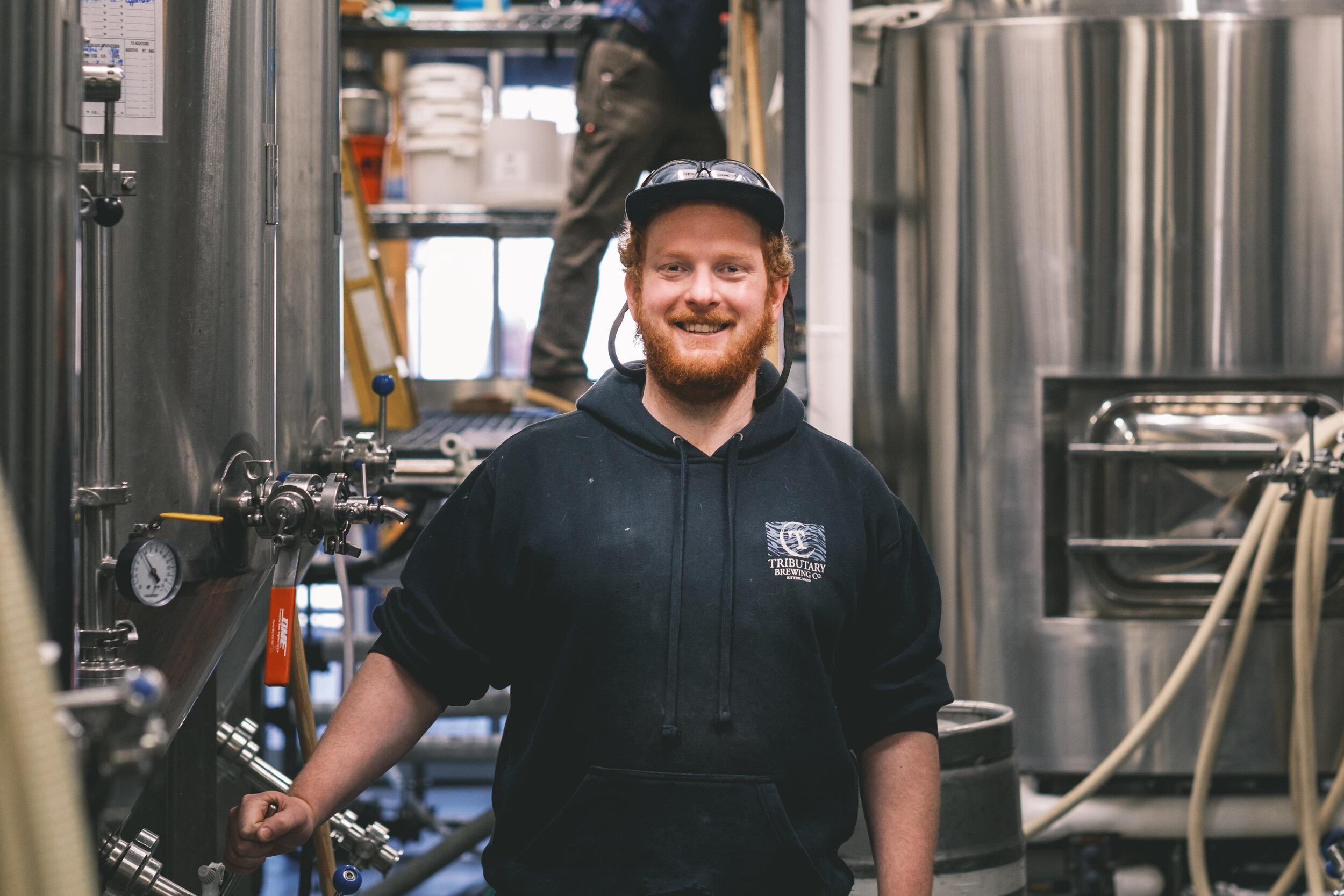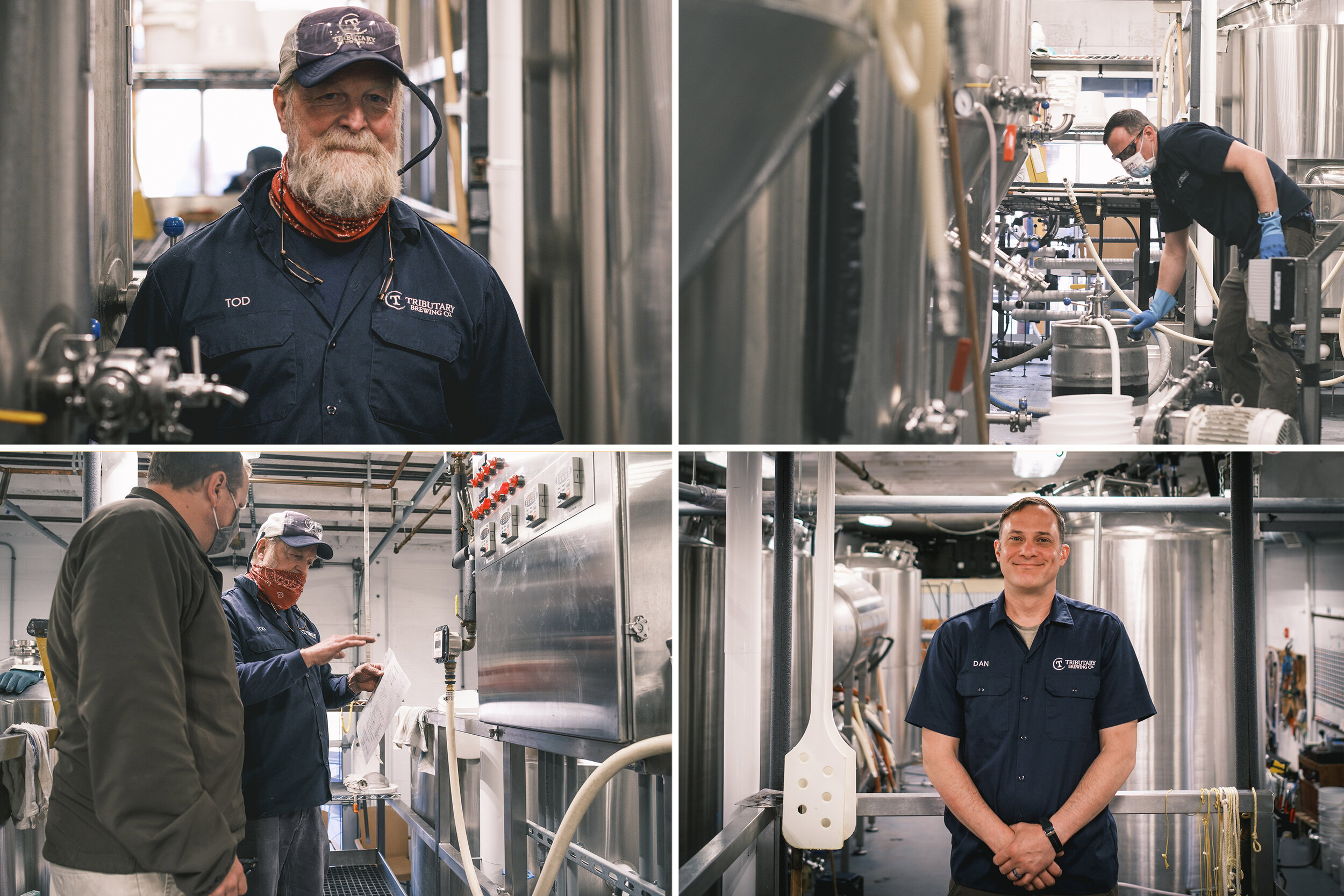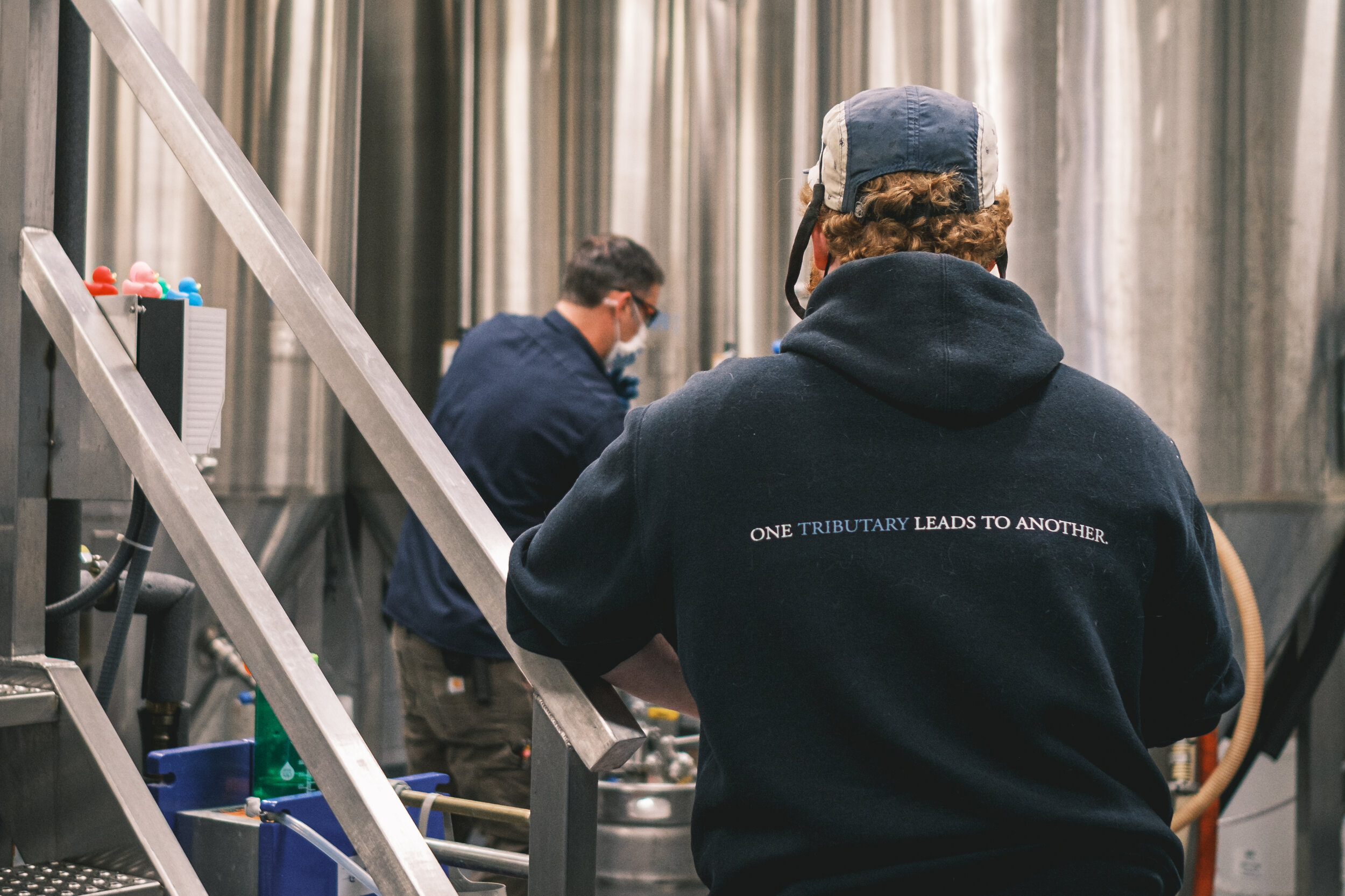There is an urgent beauty to certain New England mornings. It dazzles then disappears. The sky seems to awaken before the sun appears, like a child rustling in their bedroom before coming downstairs for the day. Brilliant pinks, blues, and oranges lighten, then linger and astound, but in their own way suggest, yes, now is the time to work. The sun first rises over the craggy coastline of southern Maine, over the shipping boats on the Piscataqua River, the first light over all the country.
“I have been drinking Tod Mott’s beer for my entire life.”
This is what I think to myself as I cross the Piscataqua via the Memorial Bridge, on my early morning journey from Portsmouth, New Hampshire to Kittery, Maine, the state’s southernmost incorporated town. That thought isn’t entirely true, but the trajectory of my drinking life has always included beers made or created by the gregarious Mott, owner and brewmaster at Tributary Brewing Company.
It’s not uncommon to walk into Tributary and be greeted by someone from the Mott family. That includes their eight-year-old yellow lab named Katie, who meets me when I arrive. “She spent her entire life in this taproom,” the blue-eyed Galen Mott might tell you, as she tells me. As the family matriarch walks toward the porch where Mott and I have met to chat, the 62-year-old perks up. “That’s my wife,” he exclaims, as if they’d been married 38 minutes and not 38 years.
The taproom is dark and quiet this morning, save for streaks of sun coming in from a side door, casting light on a large illustration of Mott. It depicts the label for Mott’s highly regarded Russian Imperial Stout, and shows his face, head slightly tilted, beard in its wild glory.
Later, we head to the brewhouse, where Mott’s son Woody and assistant brewer Dan Stampone stop to chat. It’s a leisurely beginning: Today’s brew, a Session IPA made with Michigan-grown Magnum hops, is “the easiest of brew days,” Mott says. The day’s schedule will soon grow hectic when a delivery is halted because someone, who cannot be located, has blocked the loading dock with their car, but in the meantime, Mott grows reflective in the quiet early morning.
“I’ve been at this for 30 years,” he says. “I still love coming to work, but my body is starting to get old. I’m not lifting kegs anymore. I used to pride myself on the fact I could stack the kegs myself. Yeah. And that was just three years ago now. I had my knee replaced last September. I skied on it this year, 54 miles an hour. It takes a longer time to recover.”
While Mott’s physical body might not be where it used to be, his body of work stands tall in the New England brewing scene. The so-called “journeyman” brewer not only introduced the India Pale Ale to the region, but crafted a Russian Imperial Stout that turned casual beer drinkers into fervent beer hunters.
Before we get into that, though, we must remember that this is a family affair first. And you can’t tell the story of Tributary without starting from the beginning.
“Galen runs the business,” Mott assures me. “There’s no way this happens without her.”
Tod and Galen Mott met toward the tail end of their time together at Denison University in central Ohio. He’d gone west from Greenwich, Connecticut to study ceramics; she’d traveled east from the Chicago suburbs to study art. Schooling took the pair to Sun Valley, Idaho then back to Chicago to paint houses. After Mott earned his BFA from the Kansas City Art Institute, they moved to Boston. Galen bounced around art museums in the region and ran her own decorative art studio based out of Boston.
“I have way too much schooling,” says Mott. “She was a breadwinner for a number of years.”
Life changed for the Motts, who were married in 1983, when Galen purchased Mott a homebrew kit while he was in graduate school. They were both tired of drinking Budweiser, but they couldn’t afford otherwise. “Yeah, it was probably a little of both, but I knew he loves to cook and make things,” she says. “So I knew that that would be kind of a fun hobby for him.”
She stresses “a hobby” in air quotes and adds, with honed comedic timing and pronounced sarcasm, “A 30-year hobby.”
After going it alone initially, Mott later found his place in the local homebrewing community, competing against the likes of Garrett Oliver and Phil Markowski, of Brooklyn Brewery and Two Roads Brewing Company, respectively.
“There were some amazing brewers in that homebrew club,” he says. “At the time, I had no idea who they were and they were just so gracious. They were energetic as hell. And I joined them and started brewing and the next thing I was like, man, I can parlay the ceramics into brewing and make some money.”
“We needed beer. They didn’t have any Harpoon, but I found this six-pack of Ballantine IPA. We set off and I popped it open. ‘What’s the smell? It’s the hops. It smells like weed. Whoa.’ I took a sip. I’d never tasted anything like it. I’d never had an IPA. It just floored me.”
Mott’s first professional gig was at Catamount Brewery in White River Junction, Vermont, where he learned the most important part of a brewing job is cleanliness. But Catamount was ahead of its time. The brewery had a lab, and stringent quality control standards. “Quality was the name of the game,” Mott says. “It still is. But [at Catamount I learned] you can’t make bad beer.”
The “Wally Pipp” moment in Mott’s career happened when he was asked to step in for an injured brewer at Harpoon Brewery in Boston, Massachusetts. (Pipp, who played professional baseball for the New York Yankees, famously asked to be pulled from the starting lineup because of a headache. His replacement, Lou Gehrig, went on to a Hall of Fame career at first base, and started the next 2,130 games in a Yankees uniform.)
As he tells it, Mott had an epiphany as he was getting into the groove devising recipes in his new gig. “We were up at Vinalhaven, Maine,” he says. “We needed beer. They didn’t have any Harpoon, but I found this six-pack of Ballantine IPA. We set off and I popped it open. ‘What’s the smell? It’s the hops. It smells like weed. Whoa.’ I took a sip. I’d never tasted anything like it. I’d never had an IPA. It just floored me.”
Mott decided he wanted to brew an English-style IPA, and crafted his recipe the way he still does: by beginning at the end. “What do I want this beer to taste like?” he asked himself. “What are the vital characteristics I’m looking to showcase? How do I get there?”
Convinced to use American hops, Mott settled on Cluster and Cascade because “that’s what Sierra Nevada does.” The result was a beer called Harpoon IPA, which quickly became ubiquitous in the region.
“I invented the IPA in New England,” Mott says. “It wasn’t a New England IPA. It was just a beer made in New England that just happened to have some hops in it … That was in 1992 or ’93. Jesus Christ. That was 30 years ago.”
Mott’s early experiments eventually snowballed into the avalanche that is the New England IPA. But his creation of another beer—one that followed him every step of the way in his brewing career—brought a distinct darkness, and boldness, to the beer landscape.
After Harpoon, Mott worked at Back Bay Brewing Company in Boston (which was an offshoot of Commonwealth Brewing Company, where he also spent time on the brew deck). There, he created the first iteration of a beer called Boston Strangler, a Russian Imperial Stout. The name, which referenced the perpetrator of 13 grizzly murders in Boston in the early 1960s, fortunately didn’t stick.
The recipe, which continued to evolve over time, followed him to a short stint at a brewery called Quincy Ships on Massachusetts’ South Shore and then briefly to a new start-up brewery in Haverhill, Massachusetts called Haverhill Brewery. “It’s followed me to every single brewery I’ve been at,” he says. “Then,” he shrugs, “to P-Brew.”
P-Brew is short for Portsmouth Brewery. Located along the main drag in the small waterfront town of Portsmouth, New Hampshire, the brewery is owned by Peter Egelston (who also owns Northampton Brewery, another brewpub, in Northampton, Massachusetts, and, from 1994-2018, owned Smuttynose Brewing Company). It was the height of the brewpub era, defined by house-crafted beer and good food in a convivial atmosphere built around the community. There were pint club memberships, happy hour apps, and community nights that centered on local philanthropy.
By this time, Mott had cultivated an esteemed reputation, and was seen by many in the industry as a brewing maestro whose influence resonated across the region. During his eight-year stint at Portsmouth from 2004-2012, he drew brewers who wanted to work with him. One of them was Tyler Jones.
“When I finished brewing school [at UC Davis], I knew I wanted to work for Tod,” says Jones, who now owns Black Hog Brewing in Oxford, Connecticut. “I called and left messages every two weeks.”
Jones speaks with reverence about Mott, calling him his “best friend” during their time together from 2007-2011. When Mott left Portsmouth to open Tributary, Jones took over as the lead brewer before leaving the post to open Black Hog. After learning the science side of the trade in school, Jones says he discovered a different side from Mott.
“Tod coming from the art side showed me how much of this is an art,” says Jones. “He taught me things you can’t learn from a book.”
Everything changed when, in 2007, BeerAdvocate called Mott’s Russian Imperial Stout—known then as Kate the Great, after the 18th-century empress of Russia, Catherine II—the second-best beer in the world, and the best in the U.S. The number-one spot was held by another Russian Imperial Stout named Black Albert, made by De Struise Brouwers in Oostvleteren, Belgium. In 2011, Mott journeyed to Belgium to brew a blend of Kate and Albert, which was called Kabert.
“Tod coming from the art side showed me how much of this is an art. He taught me things you can’t learn from a book.”
An oil-black, double-digit-ABV masterpiece made with 12 different malts and aged on oak spires, Kate the Great became one of the first white whales in craft beer. Every year, lines wrapped around the block on “Kate Day,” held in March.
“It really blew me away the first time people lined up,” Mott says. “Oh my god, [it was] insane. We used to sell that beer in growlers.”
Woody, Mott’s 29-year-old son and the assistant brewer at Tributary, shares a high school drinking story that’s distinct from, well, any other high school drinking story I’ve ever heard. He claims that, while his parents snoozed upstairs, he and his friends poured glasses of Kate the Great from the kegerator in the family basement. While the rest of us snuck bad macro beer into the woods, there were teenagers drinking one of the finest beers in the world, on draft, in a finished basement.
The beer exists now as Mott the Lesser. It’s since become a blend: A portion of the beer is aged in stainless steel while the remaining amount rests in four separate oak barrels rather than on oak spires. “[It’s always] two fortified wines and two distillates,” says Mott.
The specific barrels used vary year to year, from port and Madeira to rum and gin barrels. In true Kate Day spirit, there are still lines around the building when batches are released twice a year, one in the spring and another in the fall. (During COVID-19, bottles were sold online and buyers could stop by the brewery to pick them up at their convenience.) The fall 2020 batch of MtL, on tap close to six months after the release date—and just in time for my visit—features big cherry notes on the nose, but ends with a clean botanical finish from the gin barrels.
But when Mott and his staff pulled beer out of the barrels to do a sensory tasting for the spring 2021 edition of Mott the Lesser, something was off. After they detected a tartness in the Madeira barrel, the same happened with the sample from the port barrel. An infection had ruined the oaked portion of the beer (no infection reached any of the beer fermenting in stainless).
“It’s totally devastating,” Mott says. “You know, I’ve seen everything. I’ve seen everything but the spoilage in those barrels. Now I’ve seen everything.”
Fortunately, there were enough kegs filled with previous versions of the beer that Mott and his crew were able to salvage the release by blending the stainless quantity with older, fully realized batches of the beer. The result showcases “complex aromatics ranging from coffee, Belgian and milk chocolate, with fruity overtones. As one tastes this full-bodied stout, flavors of jammy plums and stone fruit give way to tannic and leather oak derivatives of the blended barrels.”
By 2012, Mott had a loyal following, had spent years mastering his craft, and was ready to leave Portsmouth to make beers “on his own dime.” He called his project Tributary, and added the tagline, “One Tributary Leads to Another…” In a literal sense, the brewery resides near the water, and that descriptor alludes to its sense of place: Every tributary leads to another tributary before the waters reach the ocean. In the metaphorical sense, the name seems to speak to the lineage of certain important beers. And, hopefully, if you have one of Mott’s Tributary beers, you’ll want another.
The timing was perfect for starting the business. “Borrowing money was cheap,” says Galen. Southern Maine had also just passed legislation to allow for a brewery to operate without serving food, and the state’s craft beer industry was hitting its stride. “I told Tod, ‘This is the time to do it,’” says Galen. “And we really wanted to be the first ones in southern Maine.”
Tributary’s quaint taproom resides in a small corner space within what used to be a supermarket, inconspicuously sandwiched between a bank and a hardware store in a shopping plaza. In an era when pastoral settings do well on social media, Mott’s spot is an unassuming one.
But he had a vision for his brewhouse. He knew what he wanted, and had the contacts to make it happen. The main goal, according to Galen, was the desire to “keep it as local as possible.” To get Mott’s beer, per usual, you had to go to him.
“Draft is best,” Mott says. “The best place to drink beer is at the source. Obviously, packaging has gotten good lately, cans are fantastic, but there is just something about draft beer. It really shows a beer’s qualities. There are a lot of great neighborhood bars that are great to drink at, a beer at home is fine, but when you can sit at a bar and talk about the beer you’re drinking with the brewer, it’s a much better experience.”
“That’s maybe why he’s not as well-known within the brewing world outside New England,” says Jones. “You always had to go to where he was brewing. Maybe you sit next to him at the bar and let him talk to you about beer. He’s a true artist. He wants you to experience the beer with him. He knows the story of his beer is told correctly by him.”
Coincidentally or not, the brewery opened on Woody’s birthday, during his senior year of college at Northeastern University in Boston. “That semester, I was taking a family business course. I wonder why I did that,” he says with a grin.
“Draft is best. The best place to drink beer is at the source. Obviously, packaging has gotten good lately, cans are fantastic, but there is just something about draft beer. It really shows a beer’s qualities. There are a lot of great neighborhood bars that are great to drink at, a beer at home is fine, but when you can sit at a bar and talk about the beer you’re drinking with the brewer, it’s a much better experience.”
Galen facetiously laments that her son, who holds a business degree, chose to work on the brewing side of the operation rather than the business side alongside his mother. But as he tells it, sitting in a cubicle turned him off from business, so he told his parents he wanted to brew. In turn, they told him, “Great, go find a job.”
Woody cast his line at a couple local breweries in Boston, including Harpoon, but got no bites. Eventually, he took a job at Wormtown Brewery in Worcester, Massachusetts, and then at Stoneface Brewing Co. in Newington, New Hampshire. When an opening finally came up at Tributary, he was recruited to join his family business.
“He is very much like Tod,” says Galen. “He is passionate about brewing and he did have some experience homebrewing and so forth. So the passion, the fire was there. He’s a great worker and he’s got a great palate and all that. He is definitely a chip off the old block.”
A father-and-son dynamic in the workplace can present some unique challenges, but Tod and Woody blend their differences and work well together in the brewhouse, they say.
“[Tod] is an iconoclastic, boisterous guy,” says Woody. “The intensity for which he expresses his desire for quality, and being this community man, and, you know, you’ll see him out there in the tasting room just chatting with customers at any opportunity. I’m a little more reserved. I am a bit of an introvert, but, nonetheless, having that balance where I’m very methodical in things where, you know, he’s like the Italian grandmother that knows how to add just enough of this, just enough of that to a recipe.”
The tap list at the tasting room reflects the brew team’s commitment to quality, but they refuse to make it easy on themselves. Instead, they’re more likely to pull from Mott’s book of recipes—according to Woody, it’s over 200 pages long—which can make Tributary feel like a bit of a throwback to the brewpub days of craft brewing. On tap the day I visit, I find an IPA, Pale Ale, California Common, Maple Porter, Helles, Belgian IPA, and the fall 2020 version of Mott the Lesser.
Maintaining quality and consistency is key to managing such a diverse tap list. In fact, Mott claims to have only dumped two batches of beer at Tributary.
“Quality, quality,” Mott says, before reemphasizing the point. “It will always be the quality of the beer, first and foremost. We’re not saving money on our malt. We’re spending a bit more to add that certain character that we want in our Pale Ale, to add that residual character. Well, we only want a little bit of it, but we want it in there because it is a flavor profile. And that’s where designing beers, you have to know what you want to do and how to get it there.”
“The big thing he taught me was recipe development,” says Jones. “His malt bills are awesome. He gives you that experience of teaching like, ‘Okay 2% of this, 5% of this, all in order to provoke this flavor.’ It’s the little things, like adding British malt into the toaster oven in the kitchen just to get a really subtle malt nuance.”
At the brewery’s opening, the New England craft beer community showed up in droves. Even still, opening a brewery was, to Mott, a “huge bet.”
“It’s so humbling,” he says. “The line for the first Mott the Lesser was, I mean, I was just blown away. There was a line literally around the building and I high-fived everybody. I think I had a beer with everybody. I was two sheets to the wind.”
Though tucked away in a shopping plaza, Tributary is less than a mile from the waters that lead to the Atlantic Ocean. Just as Mott has seen tides come and go in his native New England, he’s seen the ebb and flow of the craft beer industry over his 30-plus years in the game. The number of craft breweries has risen like a rogue wave, cresting and hitting a high-water mark. Now, as the water begins to recede, some will survive and many will sink back into the sea. From his time in the industry, Mott has learned that there are a few constants inherent to longevity.
“You put your ax to grindstone, you love what you do, and it’s not really work,” he says. “There’s a brewery in every little neighborhood. And it’s so amazing. Most of the brewers are really genuine, good, wonderful, loving, kind, fantastic people.”
These days, there are few legacy, family-owned and -operated breweries like Tributary left. And there are even fewer, if any, that feature an iconoclastic figure like Mott passing the proverbial perforated paddle to his son. There’s a legacy to preserve in every glass at Tributary.
“I’m sure continuing Tod’s legacy has been in the back of Woody’s mind,” says Jones. “But I think [Tod will] always be like the grandma looking into the kitchen. Maybe he is not mashing in, but you know he’s there, making sure you’re doing it right.”
Mott laughs at this idea and acknowledges its truth. He admits it may be close to time to pass on his recipe book. “I’ve done what I set out to do,” he says, growing reflective. “Setting up Tributary is leading to those final steps, which is handing it to Woody. He’s going to take it over after my final farewell. I have done so much for so many others, and we think it’s time to do it for ourselves.”
Making plans to step back is bittersweet, but the timing feels right. “Woody gets to carry it on,” Mott says. “I’m definitely taking a step back. I don’t have the energy I used to have. It’s time to slow down. Do some traveling. I’ve been married a long time, but we haven’t been able to enjoy a life outside of working. [Retirement] should be a wonderful journey. I’m excited to travel, and spend more, better time together.”
For his part, Woody is ready to tackle the challenge. He’s armed with that prolific recipe book, for starters. The youngest Mott was born into the beer world, and was even tutored in chemistry by the UC Davis brewing school-educated Jones as a high schooler. He knows about vagabonding around New England, about Harpoon IPA and Kate Day. He’s been around beer all his life, and recognizes how important preserving the Mott reputation is.
“Keeping the legacy that [my dad has] created for himself in proper stewardship is imperative for Tributary,” he says. “I look at myself as the steward of that legacy.”

































